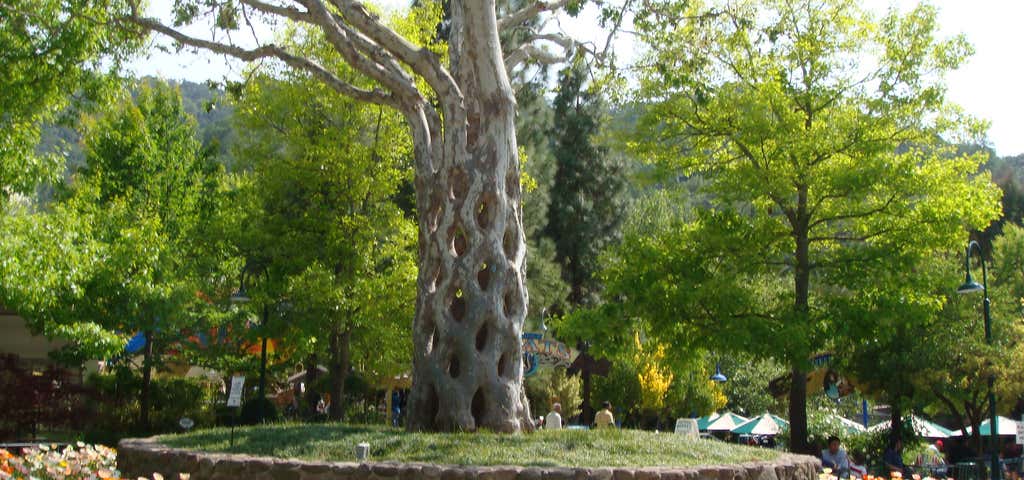"I think that I shall never see A poem lovely as a tree..."
This famous Joyce Kilmer poem sums up just what makes a tree so special. Of course, there's the science as well: Without forests to cut back on carbon dioxide, make oxygen, and provide a habitat for other plants and animals vital to our ecosystem, human life on Earth as we know it couldn't exist. And, as Kilmer so eloquently points out, they're quite nice to look at as well. From a tree that's as old as Methuselah to a veritable circus of trees, there are some pretty impressive plants that you can find across the country.
Kennedy Space Center Moon Tree
Astronaut (and former smokejumper, who fought wildfires by parachuting into remote areas) Stuart Roosa, who was part of the command module team on the 1971 Apollo 14 mission, kept hundreds of tree seeds in his personal pack during his time in space. The reason? He wanted to plant the sycamore, Douglas fir, loblolly pine, sweetgum and redwood seeds back on Earth to see if their time in space would affect their growth. Despite the fact that the seed container burst open during the mission and causing the seeds to be deemed inviable, they were planted anyways. Most, surprisingly, germinated, and in 1976, "moon trees" were sent to various institutions and government buildings across the country. One is located at the Kennedy Space Center, naturally, where you can see it today.
Charleston's Angel Oak is a whopping 400 years old (which, while impressive, you'll later see, pales in comparison to the older trees in America). Its size and shape is quite stunning, though; at 66.5 feet tall and 28 feet around, with plenty of gnarled branches, some reaching nearly 200 feet long and dripping with moss and ivy, it's certainly a sight to see. It provides approximately 17,200 square feet of shade, even, a relief from the muggy heat of Charleston. The tree's distinctive name comes from Justus Angel, who owned the estate for awhile, but of course, it has led to some great folklore. People claim to see the angels of former slaves appear around the branches.
The Tree That Owns Itself
This oak in Athens, GA may appear to be just an average tree, but there's something quite different about it-- it legally (sort of) owns itself. The tree that is popularly known as The Tree that Owns Itself is actually, in real life, the Son of the Tree that Owns Itself-- the original tree toppled over in the 1940's and was replaced with an acorn from the first oak.
According to an 1890 front-page article in the Athens Daily Banner, a man named William Jackson grew up on the property and had such fond childhood memories of the tree that he wanted to make sure that it would never, ever get cut down. So, to ensure that the tree would be protected even after his death, at some point between 1820 and 1832 he deeded ownership of the tree and surrounding land to the tree itself.
Unfortunately, if such a deed ever did exist, it would have absolutely no legal standing whatsoever. Common law 101 (and common sense) states that the person receiving the property must have the legal capacity to receive it-- and a tree isn't exactly capable of accepting any property. Plus, we now know that William Jackson did live on the same property as the tree, but as an adult, not a child. Even more suspicious, there's no evidence of such a deed, and at the time of the article, no one could remember much about how the tree came to own itself.
But, even though the deed is basically bunk in the eyes of the law, the public recognizes it wholeheartedly, and even the government has professed that they would acknowledge that the tree (and thusly, its son) owns itself. But don't worry about trespassing on its property-- you can definitely stop and visit it if you're in town!
Oak Alley Plantation is home to lovely gardens and some beautiful antebellum architecture, but the main attraction here has to be the property's namesake alley of 300-year-old live oaks. They're always green, and the quarter-mile stretch of road lined with 28 trees is absolutely gorgeous.
Methuselah Grove
3000 BC was a good year for planet Earth- pottery and hieroglyphics were invented, the city of Troy was founded, construction commenced on Stonehenge, and the world's oldest tree that's still living today germinated. That makes it an ancient 5064 years old! Think about all the things the tree has seen! Really, what hasn't it seen? The tree is located with other ancient bristlecone pines in the Methuselah Grove of the Ancient Bristlecone Pine Forest in Inyo National Forest. That's a lot of trees. The Methuselah Grove got its name from what was previously the oldest tree in the world, which was named for the Biblical figure Methuselah, who lived to be 900 years old. That's still like, toddler-age compared to the tree.
Before Methuselah and Methuselah's older brother were discovered, there was another ancient tree who people suspected was just as old, if not older-- its name was Prometheus. Unfortunately, Prometheus is no longer standing because it was cut down in a freak accident. A scientist was trying to get a sample of the tree's core to date it and got his tree-coring instrument stuck in the trunk. A ranger helped him cut it down...and that's when they realized that they were dealing with a really, really old tree-- perhaps the world's oldest. You can see the stump of where Prometheus once stood-- contrary to popular thought, the oldest trees don't always have the most rings in their cross sections, so it's easy to see why the scientist and the ranger just cut the damaged tree down.
We now know that Prometheus isn't the oldest...but we don't know exactly where the oldest tree is. The precise location of Methuselah and the current oldest tree are a secret to protect them from vandals and ne'er-do-wells, but they're somewhere inside the grove. You can walk amongst the grizzled, twisted trees (honestly, they bear a striking resemblance to an old human being, sort of gnarled and bare and all) and speculate which one might very well be the world's oldest.
Gilroy Gardens
Gilroy Gardens now owns the trees from a roadside oddity once known as The Tree Circus. Inspired by attractions like the Santa Cruz Mystery Spot, Swedish immigrant and tree-shaping hobbyist Axel Erlandson trained trees to grow in incredible shapes and patterns and then opened his incredible Tree Circus to tourists in the late 1940s. His process of getting trees to grow in woven, arches, and knotted shapes involved exhaustively pruning, grafting, and bending growing trees over the course of years, but whenever anyone asked how he managed to shape his trees, he simply answered, "I talk to them." A few of his rare Circus Trees exist outside Gilroy Gardens (one is at the American Visionary Art Museum in Baltimore, while some of the dead ones are on display at Santa Cruz's Museum of Art History) but wherever you happen to come across them, you're sure to be dazzled by them!
Just off the famed 17-Mile Drive on the Monterey Peninsula, you'll find one of the country's most photographed trees, known as the Lone Cypress. Standing alone one a cliff right over the ocean, it's a testament to just how resilient trees can be (although it now has cables holding it in place!) It's survived about 250 years, through storms, fires, and more, though, and it remains a symbol of Pebble Beach and the Monterey Coast.
Candelabra Trees
The mysterious Candelabra trees, with their many branches that bend, twist, and turn as they reach up towards the sky, may look like something from a fantasy book, but they are very real. The phenomena that causes this specific grove of redwoods to grow in the unique candelabra shape is rare-- scientists believe that the strong, salty breezes from the nearby ocean, as well as the stand's location on a cliff account for the special branches. Also, the grove of Candelabra Trees is located on California's notorious Lost Coast, which got its name from the fact that the highway system was built around it rather than along it to avoid dealing with the rocky, jagged cliffs. As a result, the area remains mostly untouched by development-- which is good for those looking to get away from it all, despite the fact that it's not exactly easy to reach. And, until very recently, the grove was located on private land. It wasn't until 2011 that the Redwood League of California was able to purchase the stand of trees, and the Lost Coast Trail was recently extended to reach the so-called Shady Dell Grove!
The Hyperion Tree is the tallest known tree in the world. It stands 379 feet tall, more than twice as tall as the Statue of Liberty (minus the base), and it's at an undisclosed location in Redwood National Park. Before Hyperion was discovered (which was shockingly not that long ago, back in 2006) Humboldt Redwood State Park's Stratosphere Giant had been known as the world's tallest: it's ten feet shorter than Hyperion. Either way, now you know why Redwood State and National Parks are such a commonly bucket-listen destination... redwood trees really are that big!
Tour-Thru Tree
Redwood trees are also frequently hollowed out for cars to drive through. There are several drive-through tunnel trees across California, like Klamath's Tour-Thru Tree. It's one of the bigger tree tunnels, so it's the one you'll definitely want to stop at if you're in an SUV or truck. Even if your car won't fit, you can walk through it!
Bicycle Swallowed by a Tree
There are loads of stories about how this tree on Washington's Vashon Island came to have a little red bike stuck in it (one of the most popular involving a boy leaving it chained to the tree and then going off to fight in a war, where he died), but the story that seems to be the most believable is that a local boy left his bike chained to the tree because it was a girl's model and he was embarrassed by it. Make a stop to visit the odd and unusual landmark, and check out the beautiful forested island.
Olympic National Park is in a breathtaking temperate rainforest and is well worth exploring in its entirety, but one of its beaches is home to an extra-unique tree. The Tree Root Cave is on the park's Kalaloch Beach, somehow still growing suspended between a gap in the shore's rocky cliffs. It's gnarled and weather-beaten, but it's managed to hang on long enough to become a popular spot for beachgoers in the park!
Whether you're looking for a tree that's old, or tall, or weirdly shaped, or even just a forest of them, take a moment to appreciate their beauty. Climb one, swing from one, carve your name into one, plant one, hug one, or even just sit under its shady branches and take a moment to relax... you won't regret it.
IntoTheWild
Earth and sky, woods and fields, lakes and rivers, the mountain and the sea, are excellent schoolmasters, and teach some of us more than we can ever learn from books. -John Lubbock
Explore More Trip Guides
The real places that inspired Gilmore Girls' Stars Hollow
- 12 Places
- 02:03
- 69 mi
California SR25: The Airline Highway
- 14 Places
- 05:41
- 213 mi














